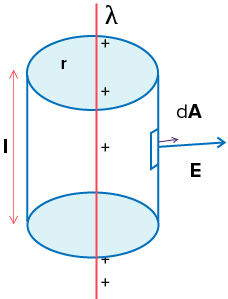Gauss Law
The Gauss law is a very convenient tool to find the electric field of a system of charges. It is especially useful when situations of symmetry can be easily exploited. The electric flux (\(d\phi \)) through a differential area is the dot product of the electric field and the area vector (this vector is normal to the area pointing towards the convex end; its magnitude is the area magnitude).
\(d\phi \,=\,\overrightarrow{E}.\overrightarrow{dA}\,=\,E.dA\,\cos \theta \).
Where \(\theta \) is the angle between the electric field and area vector. The net flux through a surface is simply the integral of the differential flux \(d\phi \).
\(\phi \,=\,\int{d\phi }\,=\,\int{\overrightarrow{E}.\overrightarrow{dA}}\).
For a closed surface such as that of a sphere, torus or a cube, this integral is represented as a loop integral \(\phi \,=\,\oint{\overrightarrow{E}.\overrightarrow{dA}}\).
Gauss Theorem: The net flux through a closed surface is directly proportional to the net charge in the volume enclosed by the closed surface.
\(\phi \,=\,\oint{\overrightarrow{E}}.\overrightarrow{dA}\,=\,\frac{{{q}_{n}}et}{{{\varepsilon }_{0}}}.\).
In simple words, the Gauss law relates the ‘flow’ of electric field lines (flux) to the charges within the enclosed surface. If there are no charges enclosed by a surface, then the net electric flux remains zero. This means that the number of electric field lines entering the surface is equal to the field lines leaving the surface.
The electric flux from any closed surface is only due to the sources (positive charges) and sinks (negative charges) of electric fields enclosed by the surface. Any charges outside the surface do not contribute to the electric flux. Also, only electric charges can act as sources or sinks of electric fields. Changing magnetic fields. For example, cannot act as sources or sinks of electric fields.
The net flux for the surface on the left is non – zero as it encloses a net charge. The net flux for the surface on the right is zero. Since it does not enclose any charge. Note that the Gauss Law is only a restatement of the Coulomb’s Law. If you apply Gauss Law to a point charge enclosed by a sphere, you will get back the Coulomb’s Law easily.

Application to an infinitely long line of Charge: Consider an infinitely long line of charge with the charge per unit length being λ. We can take advantage of the cylindrical symmetry of this situation. By symmetry, the electric fields all point radially away from the line of charge, there is no component parallel to the line of charge.
We can use a cylinder (with any arbitrary radius r and length l) centred on the line of charge as our Gaussian surface.

As you can see in the above diagram, the electric field is perpendicular to the curved surface (hence parallel to the area vector) of the cylinder. Thus, the angle between the electric field and area vector is zero and cos θ = 1. The top and bottom surfaces of the cylinder lie parallel to the electric field. Thus the angle between area vector and electric field is 90 degrees and cos θ = 0.
Thus the electric flux is only due to the curved surface:
\(\phi \,=\,\oint{\overrightarrow{E}}.\overrightarrow{dA}\),
\(\phi \,=\,{{\phi }_{curved}}\,+\,{{\phi }_{top}}\,+\,{{\phi }_{bottom}}\),
\(\phi \,=\,\oint{\overrightarrow{E}.\overrightarrow{dA}}\,=\,\int{E.dA.\cos \,0\,+\,\int{E.dA.\cos \,{{90}^{0}}}}+\,\int{E.dA.\cos \,{{90}^{0}}}\),
\(\phi \,=\,\int{E.dA.1}\).
Due to radial symmetry, the curved surface is equidistant from the line of charge and the electric field in the surface has a constant magnitude throughout.
\(\phi \,=\,\int{E.dA}\,=\,E\,\int{dA}\,=\,E.2\pi rl\).
The net charge enclosed by the surface is:
\({{q}_{n}}et\,=\,\lambda .l\).
Using Gauss theorem,
\(\phi \,=\,E.2\pi rl\,=\,\frac{{{q}_{n}}et}{{{\varepsilon }_{0}}}\,=\,\frac{\lambda .l}{{{\varepsilon }_{0}}}\),
\(E.2\pi rl\,=\,\frac{\lambda .l}{{{\varepsilon }_{0}}}\),
\(E\,=\,\frac{1}{2\pi {{\varepsilon }_{0}}}\times \frac{\lambda }{r}\).
